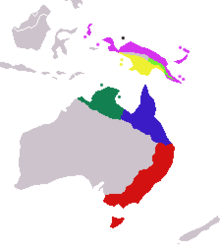| Sugar glider[1] | |
|---|---|

| |
| Illustration by Neville Cayley | |
| Scientific classification | |
| Domain: | Eukaryota |
| Kingdom: | Animalia |
| Phylum: | Chordata |
| Class: | Mammalia |
| Infraclass: | Marsupialia |
| Order: | Diprotodontia |
| Family: | Petauridae |
| Genus: | Petaurus |
| Species: | P. breviceps
|
| Binomial name | |
| Petaurus breviceps Waterhouse, 1839[3]
| |

| |
| Range map of the formerly recognized subspecies of sugar glider:[note 1] P. b. breviceps (introduced in Tasmania) | |
| Synonyms | |
|
P. (Belideus) breviceps, Waterhouse 1839 | |
The sugar glider (Petaurus breviceps) is a small, omnivorous, arboreal, and nocturnal gliding possum. The common name refers to its predilection for sugary foods such as sap and nectar and its ability to glide through the air, much like a flying squirrel.[8] They have very similar habits and appearance to the flying squirrel, despite not being closely related—an example of convergent evolution.[9] The scientific name, Petaurus breviceps, translates from Latin as "short-headed rope-dancer", a reference to their canopy acrobatics.[10]
The sugar glider is characterised by its pair of gliding membranes, known as patagia, which extend from its forelegs to its hindlegs.[11] Gliding serves as an efficient means of reaching food and evading predators.[8] The animal is covered in soft, pale grey to light brown fur which is countershaded, being lighter in colour on its underside.
The sugar glider, as strictly defined in a recent analysis, is only native to a small portion of southeastern Australia, corresponding to southern Queensland and most of New South Wales east of the Great Dividing Range; the extended species group, including populations which may or may not belong to P. breviceps, occupies a larger range covering much of coastal eastern and northern Australia, New Guinea, and nearby islands.[4][5] Members of Petaurus are popular exotic pets; these pet animals are also frequently referred to as "sugar gliders", but recent research indicates, at least for American pets, that they are not P. breviceps but a closely related species, ultimately originating from a single source near Sorong in West Papua.[12] This would possibly make them members of the Krefft's glider (P. notatus), but the taxonomy of Papuan Petaurus populations is still poorly resolved.[13]
- ^ Groves, C. P. (2005). Wilson, D. E.; Reeder, D. M. (eds.). Mammal Species of the World: A Taxonomic and Geographic Reference (3rd ed.). Baltimore: Johns Hopkins University Press. p. 55. ISBN 0-801-88221-4. OCLC 62265494.
- ^ a b Salas, L.; Dickman, C.; Helgen, K.; Winter, J.; Ellis, M.; Denny, M.; Woinarski, J.; Lunney, D.; Oakwood, M.; Menkhorst, P. & Strahan, R. (2016). "Petaurus breviceps". IUCN Red List of Threatened Species. 2016: e.T16731A21959798. doi:10.2305/IUCN.UK.2016-2.RLTS.T16731A21959798.en. Retrieved 19 November 2021.
- ^ Waterhouse, G. R. (1838). "Observations on certain modifications observed in the dentition of the Flying Opossums (the genus Petaurus of authors)". Proceedings of the Zoological Society of London. 4: 149–153. doi:10.1111/j.1096-3642.1838.tb01419.x.
- ^ a b "Petaurus breviceps Waterhouse, 1839". ASM Mammal Diversity Database. American Society of Mammalogists.
- ^ a b c Cremona, Teigan; Baker, Andrew M; Cooper, Steven J B; Montague-Drake, Rebecca; Stobo-Wilson, Alyson M; Carthew, Susan M (13 July 2020). "Integrative taxonomic investigation of Petaurus breviceps (Marsupialia: Petauridae) reveals three distinct species". Zoological Journal of the Linnean Society. 191 (2): 503–527. doi:10.1093/zoolinnean/zlaa060. ISSN 0024-4082.
- ^ Subspecies Sheet | Mammals'Planet Archived 18 August 2016 at the Wayback Machine. Planet-mammiferes.org. Retrieved 2014-04-19.
- ^ Troughton, Ellis (1945). "Diagnoses of New rare mammals from the South-West Pacific". Records of the Australian Museum. 21 (6): 373–374. doi:10.3853/j.0067-1975.21.1945.551.
- ^ a b "DPIW - Sugar Glider". 28 August 2012. Archived from the original on 28 August 2012.
- ^ "Analogy: Squirrels and Sugar Gliders". Understanding Evolution. The University of California Museum of Paleontology. Retrieved 1 October 2012.
- ^ "Sugar Glider, Petaurus breviceps". Parks & Wildlife Service, Tasmania Online. Archived from the original on 3 April 2016. Retrieved 7 October 2012.
- ^ Endo, H; Yokokawa, K; Kurohmaru, M; Hiyashi, Y (1998). "Functional anatomy of gliding membrane muscles in the sugar glider (Petaurus breviceps)". Annals of Anatomy. 180 (1): 93–96. doi:10.1016/S0940-9602(98)80149-0. PMID 9488912.
- ^ Cite error: The named reference
Campbell-2019was invoked but never defined (see the help page). - ^ "Petaurus notatus W. Peters, 1859". ASM Mammal Diversity Database. American Society of Mammalogists.
Cite error: There are <ref group=note> tags on this page, but the references will not show without a {{reflist|group=note}} template (see the help page).
